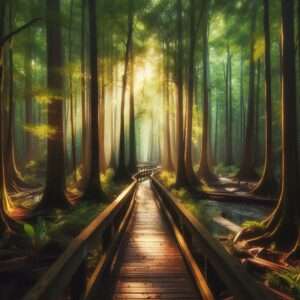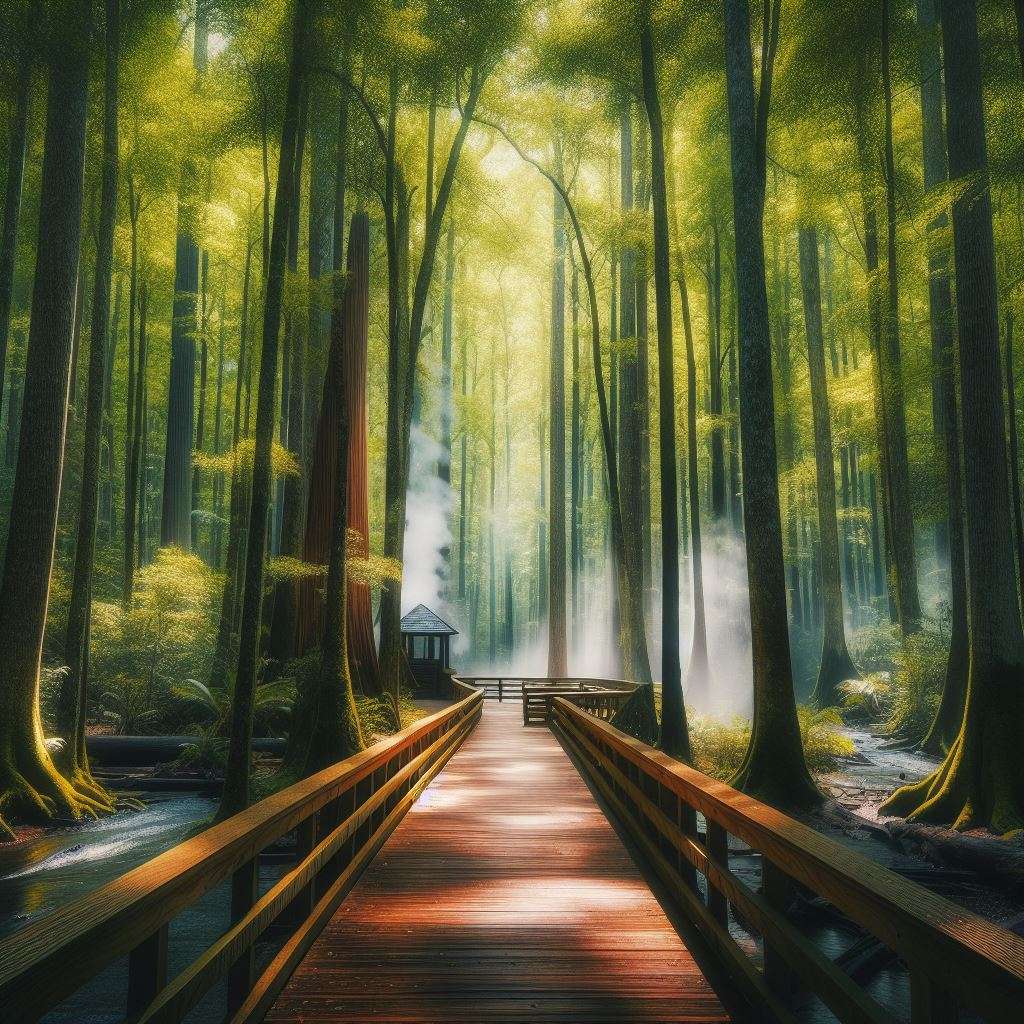Discover the Top 5 Wonders of Congaree National Park: A Comprehensive Guide
Introduction
Hey nature enthusiasts! If you’re on the lookout for an adventure that seamlessly blends wilderness and wonder, look no further than Congaree National Park. Tucked away in the heart of South Carolina, this hidden gem is more than just trees and trails – it’s a living, breathing showcase of Mother Nature’s finest work. From towering ancient trees to the soothing sounds of the Congaree River, every step in this park is a step into an untouched world of beauty.
Picture this: lush green canopies, mysterious cypress swamps, and an orchestra of birdcalls that serenade you as you explore. Congaree is not just a park; it’s a living, breathing tapestry of biodiversity that has stood the test of time. So, grab your hiking boots, your sense of adventure, and let’s embark on a journey through the awe-inspiring wonders that make Congaree National Park a haven for nature lovers.
Stay tuned as we unravel the secrets of Congaree – where every trail tells a story, and every moment is a brushstroke on the canvas of this enchanting natural masterpiece. Get ready to be captivated, because Congaree is calling, and the adventure of a lifetime awaits!
Attractions in Black Canyon of the Congaree National Park:
Displayed in the table below are the leading 25 attractions within Black Canyon of the Congaree National Park, highlighting distinctive features that distinguish each site and render it remarkable.
| # | Attraction | What’s Special |
|---|---|---|
| 1 | Boardwalk Loop Trail | Immersive elevated walkway through lush landscapes. |
| 2 | Congaree River Blue Trail | Scenic water trail with kayaking and canoeing opportunities. |
| 3 | Weston Lake Loop Trail | Tranquil trail encircling Weston Lake. |
| 4 | Old Growth Bottomland Forest | Preserved ancient forest with towering trees. |
| 5 | Bluff Trail | Trail offering elevated views of the Congaree floodplain. |
| 6 | Oakridge Trail | Path through diverse ecosystems with interpretive signage. |
| 7 | Weston Lake | Idyllic lake setting for picnics and wildlife observation. |
| 8 | Longleaf Pine Trail | Experience the park’s unique longleaf pine habitat. |
| 9 | Cedar Creek Canoe Trail | Canoe exploration along the scenic Cedar Creek. |
| 10 | King Snake Trail | Trail known for birdwatching and reptile sightings. |
| 11 | High Boardwalk Loop | Elevated boardwalk providing panoramic views. |
| 12 | Wildlife Observation | Abundance of diverse wildlife for nature enthusiasts. |
| 13 | Visitor Center Exhibits | Learn about the park’s ecology and conservation efforts. |
| 14 | Canopy Trail | Trail through the forest canopy for a unique perspective. |
| 15 | Ben Brenman Trail | Trail with access to Cedar Creek and old-growth forest. |
| 16 | Butterfly Trail | Trail known for butterfly sightings in the warmer months. |
| 17 | Firefly Display (Seasonal) | Experience synchronous firefly displays in late spring. |
| 18 | Wilderness Canoe Tour | Guided canoe tours through the park’s wilderness. |
| 19 | Spider Lily View | Scenic spot featuring blooming spider lilies. |
| 20 | River Trail | Trail along the Congaree River for riverside views. |
| 21 | Bates Ferry Trail | Trail exploring historical sites near Bates Ferry. |
| 22 | Old Bluff Trail | Trail offering elevated views of the Congaree River. |
| 23 | Congaree Bluffs Boardwalk | Boardwalk showcasing elevated views of the river. |
| 24 | Red Oak Walk | Short trail featuring vibrant red oak trees. |
| 25 | Richland Creek Canoe Trail | Canoe trail through the park’s diverse waterways. |

General Information:
What is Congaree National Park?
Congaree National Park is a pristine expanse located in South Carolina, renowned for its untouched wilderness and diverse ecosystems. It encompasses lush forests, riverbanks, and an array of flora and fauna, creating a haven for nature enthusiasts and conservationists alike.
Where can I find Congaree National Park?
Nestled in the heart of South Carolina, Congaree National Park is situated about 20 miles southeast of Columbia. Its central location makes it easily accessible, attracting visitors from across the region and beyond.
How do I get to Congaree National Park?
To reach Congaree National Park, take I-77 S from Columbia and then merge onto Bluff Road. Follow the signs to the park’s entrance. The journey provides a scenic drive through the South Carolina landscape, offering a taste of the natural beauty awaiting you.
What can I do when visiting Congaree National Park?
Congaree National Park offers a myriad of activities, including hiking, bird watching, and ranger-led programs. Explore the park’s diverse trails, attend informative talks at the visitor center, or embark on a canoe adventure to fully immerse yourself in its natural wonders.
Is there a map available for Congaree National Park?
Yes, there is a comprehensive map available for Congaree National Park, detailing the various trails, points of interest, and facilities. It’s advisable to grab a map upon entering the park or download a digital version in advance to enhance your exploration experience.
Camping:
Can I go camping at Congaree ?
Absolutely! Congaree National Park provides camping opportunities for nature enthusiasts seeking an immersive overnight experience. Set up your tent at one of the designated campgrounds and fall asleep to the soothing sounds of the park’s nocturnal symphony.
Are there RV camping options near Congaree ?
Yes, RV enthusiasts can find suitable camping options near Congaree National Park, allowing for a comfortable and convenient stay close to the natural wonders. Check with nearby campgrounds for RV facilities and availability.
Hiking and Trails:
What are the trails like at Congaree ?
Congaree National Park boasts an extensive network of trails that wind through its diverse landscapes. From the iconic Boardwalk Loop to the challenging Weston Lake Loop, each trail offers a unique perspective on the park’s natural beauty, making it a paradise for hikers of all levels.
Which are the best hikes in Congaree ?
Choosing the best hike depends on your preferences and fitness level. The Boardwalk Loop is a favorite for its accessibility and scenic views, while the Oakridge Trail provides a more challenging trek through the park’s heart, surrounded by towering trees and vibrant flora.

Wildlife:
What kind of wildlife can I expect to see at Congaree ?
Congaree National Park is teeming with diverse wildlife. From white-tailed deer and river otters to a variety of bird species, including the elusive swallow-tailed kite, visitors can encounter an abundance of fauna along the trails and waterways.
Are there alligators in Congaree ?
Yes, alligators inhabit certain areas of Congaree National Park, particularly in water bodies like creeks and ponds. Visitors should exercise caution and adhere to safety guidelines when exploring these areas to ensure a harmonious coexistence with the park’s natural inhabitants.
Activities and Attractions:
What are some recommended activities in Congaree ?
Apart from hiking, Congaree National Park offers activities such as bird watching, stargazing, and participating in ranger-led programs. Guided canoe tours are a popular choice, providing a unique perspective on the park’s waterways and ecosystem.
How can I experience the fireflies at Congaree ?
Experiencing the mesmerizing fireflies at Congaree National Park is a magical event. The synchronous firefly display typically occurs in late spring and early summer. The park holds a lottery for the Firefly Festival, granting lucky participants a chance to witness this enchanting natural phenomenon.
Is there a lottery for the Congaree firefly viewing?
Yes, there is a lottery system for the Congaree National Park firefly viewing. The lottery, typically held in advance of the Firefly Festival, allows selected individuals to witness the synchronous firefly display, creating a memorable and ethereal night in the park.
Are there canoe tours available in Congaree ?
Absolutely! Congaree National Park offers guided canoe tours, providing a unique opportunity to explore the park’s waterways. Paddle through cypress-tupelo swamps, learning about the ecosystem and wildlife from experienced guides during this immersive and educational experience.
Weather and Seasons:
What is the typical weather at Congaree National Park?
Congaree National Park experiences a humid subtropical climate. Summers are hot and humid, while winters are mild. Spring and fall offer more comfortable temperatures, making these seasons ideal for exploring the park’s trails and enjoying outdoor activities.
When is the best time to visit Congaree National Park?
The best time to visit Congaree National Park is during the spring and fall when the weather is mild, and the park’s flora and fauna are vibrant. Late spring is especially notable for the synchronous firefly display, adding an extra layer of enchantment to your visit.

Logistics:
Is there a map of Congaree National Park available?
Yes, there is a detailed map of Congaree National Park available for visitors. Whether obtained at the park’s entrance or downloaded digitally in advance, the map provides essential information to help you navigate the trails, landmarks, and facilities.
Which is the closest airport to Congaree National Park?
The closest airport to Congaree National Park is typically Columbia Metropolitan Airport (CAE). Located about 20 miles northwest of the park, this airport provides convenient access for those traveling by air.
Are there hotels near Congaree National Park?
While there are no hotels within the park itself, several accommodation options can be found in nearby towns like Columbia. These hotels offer comfortable stays for visitors exploring Congaree National Park.
Reviews and Recommendations:
What do people say in reviews about Congaree National Park?
Reviews of Congaree National Park often highlight its pristine beauty, diverse ecosystems, and the sense of tranquility it offers. Visitors appreciate the well-maintained trails, educational programs, and the opportunity to connect with nature in a unique and immersive way.
Is Congaree National Park worth visiting?
Without a doubt! Congaree National Park is absolutely worth visiting for nature lovers, adventure seekers, and anyone looking to escape into a wilderness teeming with biodiversity. The park’s unique features, from ancient trees to vibrant wildlife, make it a destination that leaves a lasting impression.
Are there recommended restaurants near Congaree National Park?
While there are no restaurants within the park, the nearby town of Columbia offers a variety of dining options. From local eateries to cafes, you can refuel after a day of exploration with a diverse selection of cuisine.
Unveiling the Marvels of Congaree National Park: Explore Ancient Giants, Synchronous Fireflies, and More!
Ancient Giants:
Congaree National Park is home to some of the tallest deciduous trees in the Eastern United States, with towering loblolly pines and towering hardwoods, some over 150 feet in height.
Biodiversity Hotspot:
Despite its relatively small size, Congaree boasts an incredible diversity of plant and animal species. It’s a biodiversity hotspot, showcasing a variety of ecosystems, including swamps, forests, and river terraces.
Champion Trees:
The park is home to numerous champion trees, including the largest loblolly pine and the national champion sweetgum. These trees are celebrated for their exceptional size within their species.
River of Light:
Congaree hosts a magical event known as synchronous fireflies, where thousands of fireflies synchronize their flashing patterns, creating a mesmerizing display. The park holds a lottery for visitors to witness this enchanting spectacle.
Canopy Cathedral:
The park’s towering trees create a canopy that allows only about 1-2% of sunlight to reach the forest floor. This unique environment supports a rich understory and diverse wildlife.
Historical Significance:
The park has a rich cultural history, with evidence of Native American settlement dating back thousands of years. Visitors can explore the remnants of old rice fields, evidence of the park’s agricultural past.
Water Wilderness:
Congaree is often referred to as a “water wilderness” due to its numerous waterways, including the Congaree River, which provides opportunities for kayaking, canoeing, and other water-based activities.
Swamp Boardwalk:
The park features a 2.4-mile boardwalk loop that takes visitors through the heart of the old-growth forest and cypress-tupelo swamp, providing an immersive experience without impacting the fragile ecosystem.
Star Gazing:
Designated as an International Dark Sky Park, Congaree offers exceptional opportunities for stargazing. On clear nights, visitors can marvel at the Milky Way and other celestial wonders.
Preserving Wilderness:
Initially designated as a national monument in 1976, Congaree National Park became a national park in 2003. Its protected status ensures the preservation of this unique wilderness for future generations to enjoy.
Answering 15 FAQs for an Unforgettable Wilderness Experience!
What makes Congaree National Park unique?
Congaree National Park stands out for its remarkable biodiversity and pristine wilderness. Home to ancient towering trees, diverse ecosystems, and enchanting firefly displays, it offers a unique natural experience.
How do I get to Congaree National Park?
The park is located about 20 miles southeast of Columbia, South Carolina. Accessible by car, visitors can take I-77 S from Columbia and merge onto Bluff Road, following signs to the park’s entrance.
Are there camping facilities in Congaree National Park?
Yes, Congaree National Park offers camping opportunities. There are designated campgrounds where visitors can set up tents and immerse themselves in the park’s natural surroundings.
What wildlife can I expect to see at Congaree National Park?
The park is home to a diverse array of wildlife, including white-tailed deer, river otters, various bird species, and even alligators in certain water bodies. Nature enthusiasts can encounter a rich tapestry of fauna during their visit.
How can I participate in the synchronous firefly viewing?
The synchronous firefly display occurs in late spring and early summer. Visitors can participate by entering the park’s lottery system, granting them the chance to witness the magical spectacle in a controlled and sustainable manner.
What is the significance of the boardwalk loop in Congaree National Park?
The 2.4-mile boardwalk loop is a crucial feature that allows visitors to explore the park’s old-growth forest and cypress-tupelo swamp without causing harm to the delicate ecosystem. It offers a unique and immersive experience.
Can I engage in water activities at Congaree National Park?
Absolutely! The park, known as a “water wilderness,” provides opportunities for kayaking, canoeing, and other water-based activities on the Congaree River, allowing visitors to experience the natural beauty from a different perspective.
What measures are in place to protect the park’s dark sky status for stargazing?
Congaree National Park is designated as an International Dark Sky Park. To protect the pristine night sky, the park implements lighting controls and educational programs to raise awareness about preserving the natural darkness of the environment.
Are there guided tours or ranger-led programs available?
Yes, the park offers ranger-led programs, guided canoe tours, and informative talks at the visitor center. These experiences enhance visitors’ understanding of the park’s history, ecology, and cultural significance.
How can I contribute to the conservation efforts at Congaree National Park?
Visitors can contribute by following Leave No Trace principles, respecting wildlife and vegetation, and participating in organized volunteer programs. Supporting the park’s conservation initiatives helps preserve its natural beauty for future generations.
Is Congaree National Park accessible for visitors with mobility challenges?
Yes, the park strives to be accessible to all. While certain trails may have challenging terrain, the Boardwalk Loop offers wheelchair-accessible paths, allowing everyone to enjoy the park’s beauty.
What is the significance of the park’s ancient trees?
The ancient trees, including towering loblolly pines and hardwoods, contribute to the park’s unique ecosystem. These trees play a crucial role in maintaining biodiversity and providing habitats for various species.
Can I fish in Congaree National Park?
Fishing is allowed in the park, but it’s catch-and-release only. Anglers can enjoy the serene riverbanks and potentially encounter diverse fish species while respecting the park’s conservation efforts.
Are there educational programs for children at Congaree National Park?
Yes, the park offers educational programs specifically designed for children. Junior Ranger programs, nature walks, and interactive exhibits at the visitor center provide engaging experiences for young visitors.
How can I stay updated on park events and activities?
To stay informed about upcoming events, ranger-led programs, and any changes in park activities, visitors can check the official Congaree National Park website, social media channels, or contact the park directly for the latest information.
You may also consider discovering information about Grand Teton National Park.

